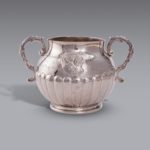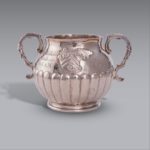
Cup, 1652 [Si17]
No assay or date mark; maker’s mark of a Hound Sejant (Richard Blackwell the Younger)
Silver: H. 12.8 cm, D. 21.7 cm, 756 g
Inscribed: Invictiss Baronis de Hadham Filii / Carolus & Henricus Capell / Ad mensa[m] Magistroru[m] Commensales [The sons of the unconquered Baron of Hadham, Charles and Henry Capell, coming to the common table of the masters]; around Wykeham’s arms: D.D. Bibliothecae in super (gratitudinis ergo) Quinq[ue] et DECEM LIBRAS [gave to the library in gratitude, five and ten (i.e. 15) pounds]
Embossed with arms of Capel and of Wykeham.
Charles and Henry Capel, the donors of this cup, entered the school as commoners in 1651 (aged 13 and 14) and left the following year. They were the sons of Baron Capel of Hadham (1608-49), one of the leading Royalist commanders in the Civil War. He was arrested after the siege of Colchester and executed in March 1649. The Capel family are the subjects of a well-known portrait by Cornelius Johnson, painted c. 1640 and now in the National Portrait Gallery. Arthur, the eldest son, succeeded to the baronry and was made Earl of Essex at the Restoration. Charles died a few years after leaving Winchester, at Christmas 1656. A volume of funeral elegies was printed at Oxford, including poems by many of Charles Capel’s school fellows (only nine copies are recorded, one in the Fellows’ Library – Bk11550). Henry became MP for Tewkesbury in 1661, served as First Lord of the Admiralty, and was ennobled in 1692. He established an exotic garden at Kew, the nucleus of the Royal Botanic Garden.
In the seventeenth century, it was often the practice for commoners (fee paying pupils) to give money to the Fellows’ Library when they entered the school. The normal amount seems to have been about ten shillings for boys being admitted ‘ad mensam puerorum’, a phrase indicating that they took their place with the boys dining in hall. Larger sums were sometimes given by pupils from wealthier families who were then admitted ‘ad mensam magistorum’ (the table of the masters) or ‘ad mensam sociorum’ (the table of the Fellows). Even so, the amount given by the Capel brothers was exceptional. The Library Donations Book (MS 225) shows that the Fellows used their gift to purchase the complete works of Albertus Magnus in twenty-one folio volumes, printed by Pierre Jammy at Lyon in 1651. These books remain in the Fellows’ Library, each stamped with the Capel arms on both boards. The bursars’ accounts record that the books cost a total of £15 (the ‘quinque et decem libras’ referred to in the inscription), and that a further £5 remaining from the Capel gift was spent on this cup.
Two-handled cups of this form first appeared in the middle of the seventeenth century. They are often known as porringers, from the French potage, and the shape probably derives from earthenware or wooden vessels used for eating soup or stew. The maker of this piece, long known only from his mark as the ‘Hound Sejant Maker’, was one of the outstanding silversmiths of the seventeenth century. He was identified in 2003 as Richard Blackwell the Younger. His father, Richard Blackwell the Elder, was also a silversmith, active from the 1600s to the 1640s. The younger Richard Blackwell was sworn to the Ordinances in 1646, but only became free of the Merchant Taylors’ Company by patrimony in 1649. Mitchell (Silversmiths in Elizabethan and Stuart London) lists 20 pieces by Blackwell the Younger, including the Winchester cup, dated from 1646/7 to 1666/7. He seems to have specialised in drinking cups and communion plate, much of it produced for the private chapels of Anglican families during the Interregnum. The College also commissioned Blackwell to make a set of eight small drinking cups, of which seven survive (Si74).
Literature: Margaret Toynbee, ‘King Charles I and Winchester College’, Proceedings of the Hampshire Field Club and Archaeological Society, 18:1 (1953), p. 26; Charles Oman, ‘The Winchester College Plate’, The Connoisseur (January, 1962), p. 29 (illustrated); Charles Oman, Caroline Silver, 1625-1688 (London, 1970), p. 39, plate 9B; T. Schroeder, British and Continental Gold and Silver in the Ashmolean Museum, 3 vols (Oxford, 2009), II, p. 662; R. Foster, Winchester College Treasury: a guide to the collections (Winchester, 2016), p. 21 (illustrated); R. Foster (ed.), 50 Treasures from Winchester College (London, 2019), pp. 17, 88-89 (illustrated); Stephen Bann, Scenes and Traces of the English Civil War (London, 2020), p. 92 (illustrated).
Provenance: Commissioned by the College from the gift of Charles and Henry Capell (Commoners, 1651-52)

